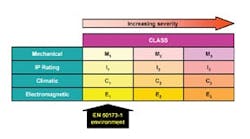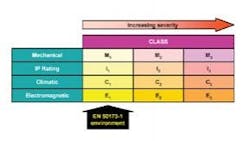The Telecommunications Industry Assn. (TIA) Subcommittee TR42.9 on Industrial Telecommunications Infrastructure is tasked with publishing TIA1005, the standard for Industrial Ethernet. Manufacturers of voice and data communication devices are well-represented in this subcommittee. Therefore, the focus tends to be mainly on the construction of the products, not the ease of installation. As it regards industrial network connection techniques, this is not good.
In response, committee members from the design and installation community are attempting to address the ease of installation issue by introducing proven industry practices for inclusion into the standard.
Standards Make It Easier, Right?
Industry standards are written to establish a set of rules for everyone to comply with. They are written for manufacturers to develop products that are intermatable and interoperable with other manufacturers' products, but, when written correctly, the end user usually is the primary beneficiary of standardization.
The standard should offer choices to end users that are best-suited for their application or environment. For example, RJ-45 is a very good interface for four-pair applications, but might be too large or overkill design-wise for certain applications. The option to use an M12-4D should be available when only two pair are required, or when panel space is an issue. A third option may be to include what is commonly known as a micronode, when floor space is critical, or when moves, adds or changes are common.
"Today, we have industrial IP67 RJ-45 connectors not because they are the perfect answer but because of the cabling industry's fixation with that style of connector. The industry needs a standard to deliver ease of installation, and provide the greatest benefit to the end user, not the manufacturers," argues Peter Sharp, senior electrical consultant with Giffels Associates (www.giffels.com) a Canadian engineering firm with extensive industrial and corporate IT infrastructure design experience.
A Standard Value
Much like our judicial system that requires the burden of proof rest with the prosecution, standards committees also must demonstrate that the directives they write add value. Especially in industries where sound practices already have been adopted. Essentially, there must be clear and convincing evidence for adopting a standards-based approach.
Standards organizations are attempting to specify a solution, or set of solutions that will stand up to harsh industrial environments. But, because those standards bodies are comprised mainly of manufacturers rather than installers or end users, the standard tends to focus on making connectors robust enough to handle the environment and not on making it easier or more efficient to install. Easy-to-install connectors can clearly benefit the end user by speeding installation and lowering the time and costs associated with implementation. "When an installer follows the standard for system integration, there is a higher level of comfort that the system will work," says Bob Lounsbury, principal engineer for Rockwell Automation and vice-chair TIA 42.9 Industrial Telecommunication Infrastructure; chair, ODVA EtherNet/IP Physical Layer; and chair, ControlNet Intl. Physical Layer. "Therefore, the standard must be written to protect end users by keeping their best interests in mind."
Once the decision has been made to standardize, the next task is to decide what to standardize on. For intermatability, the Open DeviceNet Vendors Assn. (ODVA) adopted both M12-4D for two-pair applications, and RJ-45 to satisfy the needs of four pair. "Due to the fact that the RJ-45 is so entrenched in the industry, it must be included in the standards, but for smaller solutions, an M12 is also needed", says Lounsbury.
In response to the standard, the RJ-45 interface currently has a few companies manufacturing industrial-rated solutions (Figure 1). Siemon Co., Molex and Surtec all offer intermatable "bayonet"-style designs. To be industrial-rated, the connectors must meet an IP67 rating (protection from dust and temporary water immersion). "As long as all RJ-45 or M12-style connectors have the same interface on the sealing capsule and are interoperable electrically, then end users can enjoy the benefits of standardization", says Brian Shuman, RCDD, secretary of the TR-42.9 Industrial Telecommunications Infrastructure Subcommittee; member of the EtherNet/IP PL JSIG, and senior. product development engineer, Belden Electronics.
Figure 1: Seal the Deal
In response to the need for a sealed, IP67-ratedRJ-45 solution,
many component manufacturers provide a standard intermatable
bayonet-style RJ-45 connector.
If too many companies manufacture a unique, proprietary solution industry intermatability suffers. "Commonality benefits everyone," adds Shuman. "The marketplace will be larger if everyone uses the same technology since proprietary solutions limit the total market. The end users would enjoy more choices among suppliers and benefit from the economies of scale."
Voices for Choices
The commercial office environment clearly is standardized on the RJ-45 interface. The RJ-45 is a long-established and familiar plug-and-jack combination. It also is a relatively inexpensive solution,in the office that is. However, the cost of encapsulating an RJ-45 plug and jack to meet the IP67 rating for industrial applications increases the price significantly. That fact, say many industrial users, presents the argument for choices to be included in the standard.
Many companies outsource the design and installation of their data systems to consulting companies well-versed in the industry. Therefore, the installers that are specifying systems are the customers, or end users. A number of sound industry practices have been adopted in the absence of a real standard. Designers and installers have developed and used these methods extensively to keep the integrity of the connection, while keeping in mind ease of installation.
One such practice is to put the connection inside a protected enclosure, such as the terminal strip method, or micronode. Accordingly, the definition of a micronode reads something like the description of a small telecommunications enclosure. The micronode method employs an enclosure to protect the cable terminations, active switch, and power supply. Mechanical seals at the entry point of the cable protect against ingress of liquids and dust. "Most companies we work with are making their terminations inside cabinets, or enclosures and try to avoid terminating on the outside as much as possible," says Dino Mannarino, business development and electrical consultant for Impact Technical Products, a telecommunications design and installation firm. "A micronode installation is fairly common throughout the industry. If the standard does not address this practice by including it, or a similar method, then a large portion of the industry will be excluded from using standard methods."
Micronodes work well when system changes are frequent. Systems need to be versatile enough to accommodate the users' need to add or rearrange equipment on the factory floor. "Many of today's manufacturing facilities are in a constant cycle of change," says Jim Westerman, industrial market manager, Siemon Co. "Moves, adds and changes that are constantly occurring do not allow for the use of patch panels in an industrial environment."
However, micronodes do not address connections that must be made outside of an enclosure, such as to a PLC or other control devices. "Overcoming this limitation might require that the connector receptacle be mounted on the outside of the enclosure, but IP67-rated connectors are more costly and more space consuming than necessary," reminds Sharp.
Various committees are currently preparing documents to address the need for standardization, and ISO/IEC, ODVA, TIA, CENELEC, and IOANA are all contributing. "With the number of standards bodies out there generating documents for industrial environments, following the same path is vitally important," says Lounsbury. "If all groups or consortiums go down a different path, our industry will be a mess and customers will ignore the standard."
The Matrix
To help the system designer or installer develop a solution that fits end user needs, selection tools will be available in the standard. These tools help avoid over or under-specifying a system.
Mechanical, Ingress, Climactic and Electromagnetic (MICE) is an environmental matrix used to help the installer or system designer specify the level of compliance they need (Figure 2). "The matrix defines the operating environment so that users can purchase the appropriate components," explains Robert Connell, RCDD structured cabling system specialist for Siemon Co.
Figure 2: Of MICE and Designers
The CENELEC Mechanical, Ingress, Climatic and Electromagnetic
(MICE) table used to specify required compliance levels is the model
for development of a similar table in the TIA standard.
Standards are living documents, so if another industry segment emerges and needs Ethernet, then additional solutions may also need to be included. "The ODVA DeviceNet standard addresses this requirement by using a structured guide to determine if additional solutions need to be included into the standard," adds Lounsbury. "In addition, DeviceNet allows for application-specific compliance. These are usually engineered systems and it's up to the customer to ensure compliance."
Two's Company, Three's Better
Products that comply with industry standards usually translates into lower cost. The exception comes when there is only one style or installation method. In this case, having a standard that only includes an RJ-45 interface does not seem to benefit the entire industry. "If a standard delivers only one solution, then the standards organization has not done its job," says Lounsbury. "Likewise, too many choices can have an adverse effect. Companies are asking for clear solutions, and not to leave [the issue] open. Proprietary solutions are not good for industry."
Regardless of the interface, performance must be the deciding factor. "There are good performance reasons to allow multiple connector types such as RJ-45 and M12-4 D," says Shuman. "The M12 connectors are smaller than their equally IP67-sealed RJ-45 cousins. When space is a constraint, the M12 connector provides higher performance and can be a good choice."
And, as previously stated, when frequent changes are the order of business, the micronode might be the best answer.
The installer community is concerned that not enough attention is being paid to existing practices, and how adopting those practices may speed-up the formalization of structured cabling in the industrial setting. "Standardization is a good servant, but a poor master, adds Sharp. "For serious progress to be made in the industrial Ethernet market, recognition is required of the shop-floor requirements of the industrial IT practitioner. Currently, there is too much dependence on the use of commercial building practices, with attempts made at forcing them into an industrial setting."
Ultimately, the customer will decide whether they want to be standards compliant, or not, but "keeping ease of installation in mind and creating a standard that offers choices will ultimately lead to a greater number of end users choosing to be standards compliant" adds Connell.
Kevin Russelburg , is a freelancer writer with significant network systems and electronics device experience. You can reach him at [email protected].

Leaders relevant to this article:





